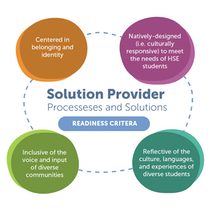If you build it, will it work? And how will you measure it? Those are vital questions for education technology innovators as they build ventures, secure funding and expand their impact. In a crowded marketplace with fierce competition for scarce dollars, savvy entrepreneurs embrace research to inspire, hone and scale their businesses.
After the pandemic, the edtech market exploded with new products and services, and investment flowed freely. But investors retrenched almost as suddenly as they emerged. Promises that your venture will transform literacy, math, social-emotional learning or professional development are no longer enough to secure funding. Your concept needs the backing of credible, empirical evidence that follows a research-to-practice trajectory.
It’s been a wild ride. When schools shuttered in the spring of 2020, more than 1 billion students worldwide shifted to online instruction in less than one month. Educators struggled to meet students' needs without proper technology tools, training and infrastructure, and edtech innovators capitalized, introducing much-needed solutions.
Amid surging demand, bullish investors plowed money into the sector, and edtech capital funding surged 297 percent from $7 billion in 2019 to $20.8 billion in 2021.
New billion-dollar unicorns emerged, with 38 edtech ventures valued collectively at $89 billion in March 2023, including firms that have become educational household names such as Newsela and Quizlet.
What happened next is a cautionary tale. In a saturated market crowded with unproven solutions, edtech investment heaved and contracted. Global edtech funding plummeted 49 percent from 2021 to 2022, falling to $10.6 billion. And it appears we're in for a hard landing in 2023, with annual funding projected to close at pre-pandemic levels of $3.5 billion.
Now, the industry is in a reset. Today’s investors and buyers demand more information, data, customer discovery and product testing to commit funding. Ventures that follow this path will be better positioned to secure funding and build sustainable businesses.

Research and evaluation are critical to uncovering consequences and affecting change. These steps can serve as a roadmap.
Step 1: Root Your Work in Research
Before you start marking up a whiteboard, hit pause. As you conceptualize your business, look for research to ground your concept. Explore qualitative and quantitative data on your intended audience and their pressing needs.
Consider these four questions to substantiate your value proposition and business model:
- What is the foundational research that supports your idea?
- What research substantiates your product or service?
- Who are the experts who can add context or insights?
- What did these researchers learn from their studies, and what do they recommend?
This framework builds a case that supports — or possibly disproves — your concept. That analysis informs your product’s features and customers and lays a solid framework for its development.
Additionally, the researchers you consult can act as early advisors, providing valuable insights and potentially studying the impact of your product when the right time comes. Those early connections can save you precious time and resources as you further design and even co-create your solution with customers.
Step 2: Support Unmet Needs and Address Stated Pain Points
Your venture should be more than an exciting idea. To attract sought-after funding, edtech startups should solve an existing problem. If you’ve pursued research to support your concepts, it should point to prospective use cases. What “pain” are you addressing within school ecosystems? What value are you adding with the solution you’re providing? How do you distinguish between buyers of your product, such as district leaders or principals, and end users, such as students or instructors? From there, innovators can refine and validate their concepts.
For example, not all education solutions fit existing needs. A small suburban school district in New Jersey is very different from a sizable county-based system in Florida. A small rural community college won’t have the exact needs of a large urban university. Young readers may require vastly different literacy support than non-native English high schoolers. It’s critical to understand and communicate if your solution is niche or offers broad applications.
And remember, most K-12 school districts and higher education systems publish their strategic plans. Do your homework to align your solution to their strategic objective. Be creative in identifying unmet needs. Determine how you differentiate from competitors who may be doing something similar.
Step 3: Seek Guidance, Mentorship and Feedback
It’s time to nurture your developing business, and startups in any industry benefit from experienced, insightful support. Seasoned investors, entrepreneurship educators and established innovators in your field can be guides. Catalyst @ Penn GSE supports entrepreneurs with resources, mentorship and community, including support through our free virtual accelerator, Catapult.
Lean into your advisors for critical insights on the market, the team, potential customers, partners and competitors, and employees. Be prepared for probing conversations and be open to adapting or pivoting based on feedback and user testing.
Your end-users are a critical sounding board as well. Query educators, students and administrators about their needs and challenges, and give them a sneak peek at your model.
Educators need early insight into the efficacy of the learning tools their schools and districts purchase. In a recent survey, only about one-quarter of teachers and principals say they have information about the effectiveness of their digital learning tools. Developers must consult key user groups to ensure they have opportunities for authentic feedback, which opens opportunities for product adaptations and even pivots.
Step 4: Prove Your Effectiveness and Determine Scalability
It’s never too early to plant the seeds for future success, including how to expand your customer base and tweak your product.
Unicorns like Newsela and Quizlet learned how to scale by ensuring their solutions were engaging, pedagogically aligned and easy to adopt.
As you grow and scale, research remains your north star. Gather quantitative and qualitative information from early users and subject-matter experts as you test and implement solutions. Your findings may lead you to redirect your plans or open new pathways.
Collecting early and continuous user feedback is essential to inform these strategic decisions, and proper measurement helps build a more sustainable and successful venture.

The Bottom Line: Research Leads to Impact and Sound Practice
By grounding their work in foundational research, innovators begin from a position of strength. This creates a foundation to design through customer discovery, co-creation with users and buyers, and driving toward evidence of effectiveness. When inquisitive investors seek evidence, innovators who follow a research-to-practice trajectory will have the logic, insights and support necessary to secure critical funding and build a successful venture that makes the impact they seek.
- SEO Powered Content & PR Distribution. Get Amplified Today.
- PlatoData.Network Vertical Generative Ai. Empower Yourself. Access Here.
- PlatoAiStream. Web3 Intelligence. Knowledge Amplified. Access Here.
- PlatoESG. Carbon, CleanTech, Energy, Environment, Solar, Waste Management. Access Here.
- PlatoHealth. Biotech and Clinical Trials Intelligence. Access Here.
- Source: https://www.edsurge.com/news/2024-01-26-research-to-impact-four-steps-to-build-a-successful-edtech-enterprise
- :has
- :is
- :not
- $3
- $UP
- 000
- 1
- 19
- 2010
- 2019
- 2020
- 2021
- 2022
- 2023
- 22
- 49
- 8
- a
- About
- accelerator
- Act
- Adaptations
- add
- adding
- address
- addressing
- administrators
- adopt
- advisors
- affecting
- align
- aligned
- All
- almost
- along
- an
- analysis
- and
- and infrastructure
- any
- appears
- applications
- ARE
- AS
- At
- attract
- audience
- Authentic
- awarded
- backing
- base
- based
- BE
- become
- been
- begin
- benefit
- Better
- between
- Billion
- board
- Bottom
- broad
- build
- builds
- Bullish
- business
- business model
- business plan
- businesses
- but
- buyers
- by
- CAN
- capital
- capitalized
- case
- cases
- Cash
- Catalyst
- Cautionary
- celebrates
- Center
- challenges
- change
- changing
- Close
- co-creation
- collectively
- College
- comes
- commit
- communicate
- community
- community college
- Companies
- competing
- competition
- competitors
- concept
- concepts
- Connections
- Consequences
- content
- context
- continuous
- conversations
- creates
- Creative
- credible
- critical
- crop
- crowded
- customer
- customer base
- Customers
- data
- decisions
- dedicated
- delivers
- Demand
- deploy
- Design
- Determine
- develop
- developers
- developing
- Development
- DID
- different
- differentiate
- digital
- discovery
- distinguish
- district
- do
- doing
- dollars
- driving
- Early
- easy
- Ecosystems
- edtech
- Education
- educational
- educators
- effectiveness
- efficacy
- embedded
- embrace
- emerged
- employees
- end
- engaging
- English
- enough
- ensure
- ensuring
- Enterprise
- entrepreneurs
- entrepreneurship
- essential
- established
- evaluation
- Even
- evidence
- example
- exciting
- existing
- Expand
- experienced
- experts
- explore
- Face
- Falling
- Features
- February
- feedback
- FFF
- field
- fierce
- final
- findings
- firms
- fit
- florida
- Focus
- follow
- follows
- For
- Foundation
- Foundational
- four
- Framework
- Free
- freely
- from
- from 2021
- funding
- further
- future
- gather
- Give
- Global
- Ground
- Group’s
- Grow
- guidance
- Guides
- happened
- Hard
- Have
- helps
- High
- higher
- Higher education
- his
- Hit
- homework
- household
- How
- How To
- HTTPS
- idea
- identifying
- if
- Impact
- implement
- in
- Including
- industry
- inform
- information
- informs
- Infrastructure
- Innovation
- innovative
- innovators
- insight
- insightful
- insights
- inspire
- intended
- into
- introducing
- investment
- Investors
- IT
- ITS
- January
- Jersey
- jpg
- Key
- Kind
- landing
- landscape
- large
- Lays
- lead
- leaders
- Leads
- LEARN
- learned
- learners
- learning
- less
- levels
- like
- Line
- literacy
- logic
- longer
- Look
- MAKES
- March
- Market
- marketplace
- marking
- math
- max-width
- May..
- measure
- measurement
- Meet
- Mentorship
- million
- model
- money
- more
- most
- much-needed
- must
- names
- necessary
- Need
- needs
- never
- New
- New Jersey
- new products
- New York
- news
- next
- niche
- no
- non-native
- North
- now
- nurture
- objective
- of
- Offers
- on
- ONE
- ongoing
- online
- only
- open
- opens
- opportunities
- or
- our
- over
- Pain
- pandemic
- partners
- passionate
- path
- pathways
- pause
- Penn
- Pennsylvania
- percent
- Pitch
- Pivots
- plan
- plans
- plant
- plato
- Plato Data Intelligence
- PlatoData
- Point
- position
- positioned
- possibly
- potential
- potential customers
- potentially
- Precious
- prepared
- pressing
- pressing needs
- prestigious
- principals
- Problem
- Product
- Product testing
- Products
- Products and Services
- professional
- Programming
- projected
- promises
- proper
- proposition
- prospective
- Prove
- proven
- providing
- publish
- purchase
- qualitative
- quantitative
- Questions
- RE
- readers
- recent
- recommend
- redirect
- refine
- remains
- remember
- require
- research
- researchers
- Resources
- Ride
- right
- roadmap
- root
- Rural
- Save
- savvy
- say
- Scale
- Scarce
- School
- Schools
- seasoned
- sector
- secure
- seeds
- Seek
- serve
- service
- Services
- Shape
- shifted
- should
- similar
- since
- sizable
- small
- smith
- sneak
- solid
- solution
- Solutions
- SOLVE
- something
- Sound
- spring
- Star
- start
- Startups
- stated
- Steps
- Strategic
- strength
- Students
- studies
- Studying
- success
- successful
- such
- support
- Supporting
- supporting education
- Supports
- Surged
- surging
- Survey
- sustainable
- system
- systemic
- Systems
- tale
- teachers
- team
- Technology
- test
- Testing
- than
- that
- The
- their
- Them
- There.
- These
- they
- this
- those
- Through
- time
- Title
- to
- today’s
- too
- tools
- toward
- Training
- trajectory
- Transform
- transforms
- true
- tweak
- understand
- unicorns
- university
- University of Pennsylvania
- unmet
- urban
- use
- User
- users
- VALIDATE
- Valuable
- value
- value proposition
- valued
- venture
- Ventures
- very
- Virtual
- vital
- we
- WELL
- were
- What
- when
- which
- WHO
- Wild
- will
- with
- within
- without
- Work
- worldwide
- york
- you
- young
- Your
- youtube
- zephyrnet











